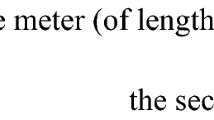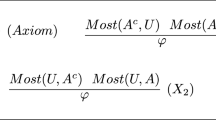Abstract
According to what I call the Traditional View, there is a fundamental semantic distinction between counting and measuring, which is reflected in two fundamentally different sorts of scales: discrete cardinality scales and dense measurement scales. Opposed to the Traditional View is a thesis known as the Universal Density of Measurement: there is no fundamental semantic distinction between counting and measuring, and all natural language scales are dense. This paper considers a new argument for the latter, based on a puzzle I call the Fractional Cardinalities Puzzle: if answers to ‘how many’-questions always designate cardinalities, and if cardinalities are necessarily discrete, then how can e.g. ‘2.38’ be a correct answer to the question ‘How many ounces of water are in the beaker?’? If cardinality scales are dense, then the answer is obvious: ‘2.38’ designates a fractional cardinality, contra the Traditional View. However, I provide novel evidence showing that ‘many’ is not uniformly associated with the dimension of cardinality across contexts, and so ‘how many’-questions can ask about other kinds of measures, including e.g. volume. By combining independently motivated analyses of cardinal adjectives, measure phrases, complex fractions, and degrees, I develop a semantics intended to defend the Traditional View against purported counterexamples like this and others which have received a fair amount of recent philosophical attention.
Similar content being viewed by others
References
Anderson, C., & Morzycki, M. (2015). Degrees as kinds. Natural Language & Linguistic Theory, 33(3), 791–828.
Balcerak-Jackson, B., & Penka, D. (2017). Number word constructions, degree semantics and the metaphysics of degrees. Linguistics and Philosophy, 40(4), 347–372.
Bale, A. (2008). A universal scale of comparison. Linguistics and Philosophy, 31(1), 1–55.
Bale, A., & Barner, D. (2009). The interpretation of functional heads: Using comparatives to explore the mass/count distinction. Journal of Semantics, 26, 217–252.
Barner, D., & Snedeker, J. (2005). Quantity judgments and individuation: Evidence that mass nouns count. Cognition, 97(1), 41–66.
Barwise, J., & Cooper, R. (1981). Generalized quantifiers and natural language. Linguistics and Philosophy, 4(2), 159–219.
Breheny, R. (2008). A new look at the semantics and pragmatics of numerically quantified noun phrases. Journal of Semantics, 25(2), 93–139.
Carrara, M., & Lando, G. (2017). Composition and relative counting. Dialectica, 71(4), 489–529.
Chierchia, G. (1998). Reference to kinds across languages. Natural Language Semantics, 6, 339–405.
Chierchia, G. (2005). Mass nouns, number marking and semantic variation. Talk given at CUNY Linguistics Colloquium, November 10, 2005.
Fox, D., & Hackl, M. (2007). The universal density of measurement. Linguistics and Philosophy, 29(5), 537–586.
Frege, G. (1884). Grundlagen der Arithmetik. Berlin: Springer.
Frege, G. (1903). Grundgesetze der Arithmetik II. Hildesheim: Olms.
Grim, S., & Levin, B. (2016). Artifact nouns: Reference and countability. In A. Lamont, & K. Tetzloff (Eds.), Proceedings of the 47th Annual Meeting of North East Linguistic Society (NELS 47) (Vol. 2, pp. 55–64). Amherst, MA: GLSA.
Groenendijk, J., & Stokhof, M. (1991). Dynamic predicate logic. Linguistics and Philosophy, 14(1), 39–100.
Hackl, M. (2000). Comparative quantifiers. PhD thesis, Massachusetts Institute of Technology.
Ionin, T., & Matushansky, O. (2006). The composition of complex cardinals. Journal of Semantics, 23(4), 315–360.
Ionin, T., Matushansky, O., & Ruys, E. G. (2006). Parts of speech: Toward a unified semantics for partitives. In C. Davis, A. R. Deal, & Y. Zabbal (Eds.), Proceedings of the 36th Annual Meeting of the North East Linguistic Society (NELS 36) (Vol. 1, pp. 357–370). Amherst MA: GLSA.
Karttunen, L. (1977). Syntax and semantics of questions. Linguistics and Philosophy, 1(1), 3–44.
Kennedy, C. (2015). A “de-fregean” semantics (and neo-gricean pragmatics) for modified and unmodified numerals. Semantics and Pragmatics, 8(10), 1–44.
Kennedy, C., & Stanley, J. (2009). On average. Mind, 118, 586–646.
Krifka, M. (1989). Nominal reference, temporal constitution, and quantification in event semantics. In J. von Bentham, R. Bartsch, & P. von Emde Boas (Eds.), Semantics and contextual expressions (pp. 72–115). Dordrecht: Foris.
Krifka, M. (1990). Boolean and non-Boolean and. In L. Kalman & L. Polos (Eds.), Papers from the Second Symposium on Logic and Language (pp. 161–188). Budapest: Akademmiai Kiado.
Landman, F. (2004). Indefinites and the type of sets. Oxford: Blackwell.
Lasersohn, P. (2013). Plurality, conjunction and events. Berlin: Springer.
Liebesman, D. (2015). We do not count by identity. Australasian Journal of Philosophy, 93(1), 21–42.
Liebesman, D. (2016). Counting as a type of measuring. Philosopher’s Imprint, 16, 1–25.
Link, G. (1983). The logical analysis of plurals and mass terms: A lattice-theoretic approach. In R. Bäuerle, C. Schwarze, & A. von Stechow (Eds.), Meaning, use, and interpretation of language (pp. 303–323). Berlin: De Gruyter.
Marti, L. (2017). Zero N: Number features and\(\bot \). Ms., Queen Mary University of London.
Moltmann, F. (2013). Reference to numbers in natural language. Philosophical Studies, 162, 499–536.
Nicolas, D. (2016). Interprétons-nous de la même manière les expressions deux pommes et deux pommes et demie? Travaux de linguistique, 1, 107–119.
Partee, B. (1986). Noun phrase interpretation and type-shifting principles. In J. Groenendijk, D. de Jongh, & M. Stokhof (Eds.), Studies in discourse representation theory and the theory of generalized quantifiers (pp. 114–144). Dordrecht: Foris.
Partee, B., & Borschev, V. (2012). Sortal, relational, and functional interpretations of nouns and russian container constructions. Journal of Semantics, 29, 445–486.
Partee, B., & Rooth, M. (1983). Generalized conjunction and type ambiguity. In R. Bäuerle, C. Schwarze, & A. von Stechow (Eds.), Meaning, use, and interpretation of language (pp. 361–383). Berlin: De Gruyter.
Pelletier, F. J. (1975). Non-singular reference: Some preliminaries. In F. J. Pelletier (Ed.), Mass terms: Some philosophical problems (pp. 1–14). Dordrecht: Springer.
Portner, P. (2009). Modality. Oxford: Oxford University Press.
Rett, J. (2008). Degree modification in natural language. PhD thesis, Rutgers University.
Rett, J. (2014). The polysemy of measurement. Lingua, 143, 242–266.
Rothstein, S. (2009). Individuating and measure readings of classifier constructions: Evidence from modern Hebrew. Brill’s Annual of Afroasiatic Languages and Linguistics, 1, 106–145.
Rothstein, S. (2016). Counting and measuring: A theoretical and crosslinguistic account. Baltic International Yearbook of Cognition, Logic and Communication, 11. https://doi.org/10.4148/1944-3676.1106.
Rothstein, S. (2017). Semantics for counting and measuring. Cambridge: Cambridge University Press.
Rullman, H. (1993). Scope ambiguities in how many-questions. Ms., University of Massachusetts.
Salmon, N. (1997). Wholes, parts, and numbers. Nous Supplement: Philosophical Perspectives 11: Mind, Causation, and World, 31, 1–15.
Schmitt, V. (2013). Boolean and non-Boolean conjunction. Ms., Universität Wien.
Schwarzschild, R. (2002). The grammar of measurement. Semantics and Linguistic Theory, 12, 225–245. https://doi.org/10.3765/salt.v12i0.2870.
Schwarzschild, R. (2005). Measure phrases as modifiers of adjectives. Recherches Linguistiques de Vincennes, 34, 207–228.
Scontras, G. (2014). The semantics of measurement. PhD thesis, Harvard University.
Scontras, G., Davidson, K., Deal, A. R., & Murray, S. E. (2017). Who has more? The influence of linguistic form on quantity judgments. Proceedings of the Linguistic Society of America, 2. https://doi.org/10.3765/plsa.v2i0.4097.
Snyder, E. (2017). Numbers and cardinalities: What’s really wrong with the easy argument? Linguistics and Philosophy, 40(4), 373–400.
Snyder, E., & Barlew, J. (2016). The universal measurer. Proceedings of Sinn und Bedeutung, 20, 658–675. https://ojs.ub.unikonstanz.de/sub/index.php/sub/article/view/288.
Snyder, E., & Barlew, J. (2019). How to count \(2\frac{1}{2}\) oranges. Australasian Journal of Philosophy, 97, 792–808.
Snyder, E., & Shapiro, S. (2016). Frege on the reals. In P. Ebert & M. Rossberg (Eds.), Essays on Frege’s basic laws of arithmetic (pp. 343–383). Oxford: Oxford University Press.
Solt, S. (2009). The semantics of adjectives of quantity. PhD thesis, The City University of New York.
Solt, S. (2014). Q-adjectives and the semantics of quantity. Journal of Semantics, 32(2), 221–273.
Wellwood, A. (2018). Structure preservation in comparatives. Semantics and Linguistic Theory, 28, 78–99. https://doi.org/10.3765/salt.v28i0.4413.
Wellwood, A. (2019). WHAT more IS. Philosophical Perspectives. Perspectives, 32(1), 454–486.
Author information
Authors and Affiliations
Corresponding author
Additional information
Publisher's Note
Springer Nature remains neutral with regard to jurisdictional claims in published maps and institutional affiliations.
This publication was funded by LMU Munich’s Institutional Strategy LMUexcellent within the framework of the German Excellence Initiative.
Rights and permissions
About this article
Cite this article
Snyder, E. Counting, measuring, and the fractional cardinalities puzzle. Linguist and Philos 44, 513–550 (2021). https://doi.org/10.1007/s10988-020-09297-5
Published:
Issue Date:
DOI: https://doi.org/10.1007/s10988-020-09297-5




